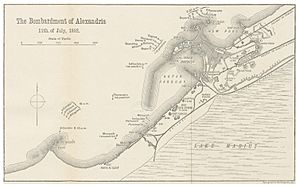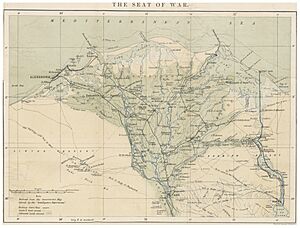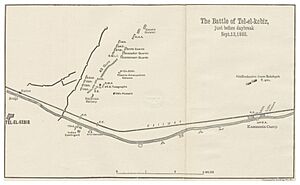Anglo-Egyptian War facts for kids
Quick facts for kids Anglo-Egyptian War |
|||||||
|---|---|---|---|---|---|---|---|
| Part of the ʻUrabi Revolt and Scramble for Africa and dissolution of the Ottoman Empire | |||||||
 French map of the military operations in Egypt |
|||||||
|
|||||||
| Belligerents | |||||||
| Commanders and leaders | |||||||
|
|
||||||
| Strength | |||||||
| 40,560 regulars |
|
||||||
| Casualties and losses | |||||||
|
2,000–4,000 killed or wounded (British estimates) | ||||||
The British conquest of Egypt (1882), also known as the Anglo-Egyptian War, was a short but important conflict in 1882. It happened between Egyptian and Sudanese forces led by Ahmed ‘Urabi and the United Kingdom. This war ended a nationalist uprising against the Egyptian ruler, Tewfik Pasha, known as the Khedive. The British victory led to them having strong control over Egypt. This reduced the power of both the Egyptians and the Ottoman Empire.
Contents
Background to the Conflict
In 1881, an Egyptian army officer named Ahmed ‘Urabi started a revolt. He was unhappy about how Egyptian soldiers were paid less than European soldiers. He also had other concerns about the Khedive's rule.
In January 1882, the British and French governments sent a message to Egypt. They said they supported the Khedive's authority. On May 20, British and French warships arrived near Alexandria.
On June 11, there was violence in Alexandria where many Europeans were killed. Colonel ‘Urabi ordered his soldiers to stop the unrest. However, many Europeans left the city, and ‘Urabi's army started making the city stronger. The French ships went back to France. The British then gave an ultimatum, which was rejected. So, on July 11, British warships began to attack Alexandria for over ten hours.
Why Did Britain Invade?
Historians have different ideas about why Britain sent its ships to Alexandria. One main reason was to protect the Suez Canal. This canal was a very important shipping route for Britain to reach India and other parts of Asia. The British worried that the ‘Urabi revolt might threaten this vital waterway.
Another reason was to protect British money invested in Egypt. Many British people had bought bonds in Egypt, especially after the Khedive borrowed a lot of money to build the Suez Canal. Some believed that the British government wanted to protect these financial interests.
Some historians also suggest that British leaders wanted to show their power. They thought a strong foreign policy might make them more popular at home. Others argue that some British officials exaggerated the danger in Egypt. They might have made the situation seem worse to convince their government to act. For example, some believed that Admiral Beauchamp Seymour made the threat to his ships seem greater. This might have sped up the decision to bombard Alexandria.
Course of the War
British Bombardment of Alexandria
The British fleet attacked Alexandria from July 11 to 13. After the attack, British marines took control of the city. The British ships were not damaged, but much of Alexandria was destroyed by fires. These fires were caused by explosive shells and, according to British reports, by ‘Urabi's supporters.
The Khedive Tewfik Pasha had moved his court to Alexandria. He declared ‘Urabi a rebel and removed him from his government positions.
‘Urabi's Response
‘Urabi then got a religious ruling, called a fatwa, from religious leaders at Al Azhar. This ruling said that Tewfik was a traitor to his country and religion. It also said that anyone fighting against Tewfik was doing the right thing. ‘Urabi then declared war on the United Kingdom and started drafting people into his army.
British Military Strategy
The British Army first tried to attack Cairo through Alexandria at Kafr El Dawwar. But the Egyptian defenses were too strong. So, they decided to change their plan.
In August, a large British army of over 40,000 soldiers arrived. It was led by Garnet Wolseley. He was ordered to defeat ‘Urabi's forces and clear the country of rebels. Wolseley saw the campaign as a challenge of moving supplies and troops. He believed the Egyptians would not fight very hard.
Battle of Kafr El Dawwar
This battle happened on August 5, 1882. It was between ‘Urabi's Egyptian army and British forces. The British wanted to check how strong the Egyptian defenses were at Kafr El Dawwar. They also wanted to see if rumors of Egyptian retreat were true.
The British made a small attack to test the Egyptian lines. ‘Urabi reported this as a big battle where the British were pushed back. However, most historians say it was just a small scouting mission. After this, the British decided not to try to reach Cairo from the north. They moved their main base to Ismailia.
Wolseley arrived in Alexandria on August 15. He quickly started moving troops through the Suez Canal to Ismailia. Ismailia was taken without a fight on August 20.
Battle of Tell El Kebir
Ismailia quickly received 9,000 more British troops. Engineers began fixing the railway line from Suez. A small group of soldiers moved along the Sweet Water Canal to the Kassassin lock. They arrived there on August 26 and met the Egyptian army.
The British soldiers were greatly outnumbered. But they held their ground until more cavalry arrived. Then, they attacked and forced ‘Urabi's forces to retreat. The Egyptians suffered many casualties.
The main British army then moved to Kassassin. They started planning for the big battle at Tell El Kebir. On September 12, everything was ready. That night, the army marched towards the battle site.
On September 13, ‘Urabi moved his forces to defend Cairo. His main army dug in at Tell El Kebir. This was north of the railway and the Sweet Water Canal, which connected Cairo to Ismailia. The defenses were built quickly. ‘Urabi's forces had 60 artillery pieces and modern rifles.
Wolseley had scouted the area himself. He noticed that the Egyptians did not guard their front lines at night. This meant the British could approach in the dark. Wolseley sent his army to attack the Egyptian position from the front at dawn.
The attack was not a complete surprise. Rifle and artillery fire started when the British were about 600 yards away. The British kept advancing. The smoke from the Egyptian weapons made it hard for them to see. The British soldiers reached the Egyptian trenches together and quickly won a decisive victory.
The British officially lost only 57 soldiers. About two thousand Egyptians were killed. More British soldiers suffered from heatstroke than from enemy action. ‘Urabi's forces were completely defeated. British cavalry chased them and captured Cairo, which was left undefended.
After the war, power was given back to the Khedive. Most of the British army left Egypt. However, a smaller British army stayed behind to occupy the country starting in November. Lieutenant William Mordaunt Marsh Edwards received a Victoria Cross for his bravery in the battle.
British Military Innovations
Railway Use
During the build-up to the battle at Tell El Kebir, a special British railway company helped a lot. They ran trains carrying supplies and troops. They also repaired railway tracks. On the day of the battle, September 13, they ran a train into Tell El Kebir station. The station was full of enemy ammunition trains and wounded soldiers. Once it was cleared, they used the trains to move wounded soldiers, prisoners, and supplies.
Telegraph Communication
As the British army advanced, telegraph lines were quickly laid. These lines ran along both sides of the Sweet Water Canal. At 2 AM on September 13, Wolseley successfully sent a message to his general on the far left of the army. At Tell El Kebir, a field telegraph office was set up in a special train car. This was the same car ‘Urabi Pasha had used the day before. At 8:30 AM on September 13, after winning the battle, Wolseley used the telegraph to send news of his victory to Queen Victoria. He received a reply from her just 45 minutes later.
Army Post Office Corps
This campaign saw the first use of the Royal Engineers (Postal Section). These were post office clerks who were also trained as soldiers. For the first time in British military history, they provided a dedicated postal service to the army in the field. During the battle of Kassassin, they were the first volunteer soldiers to experience enemy fire.
Aftermath of the War
‘Urabi's Trial
At first, British Prime Minister Gladstone wanted to put ‘Urabi on trial and execute him. He tried to make ‘Urabi seem like a cruel leader. However, after looking at ‘Urabi's captured diaries, there wasn't enough evidence to make him look bad in a public trial. So, the charges against him were reduced. ‘Urabi admitted to rebellion and was sent away into exile.
British Occupation
British troops stayed in Egypt after the war. They occupied the country until the Anglo-Egyptian Treaty of 1922 and Anglo-Egyptian treaty of 1936. These treaties slowly gave control back to the Egyptian government.
Britain continued its occupation of Egypt to protect its investments. British leaders felt they could only leave if their financial interests were safe. Because of this, British investment in Egypt actually grew during the occupation. Interest rates fell, and the value of bonds rose.
Images for kids
See also
- Egypt Medal
- Khedive's Star
- List of conflicts in the Near East







